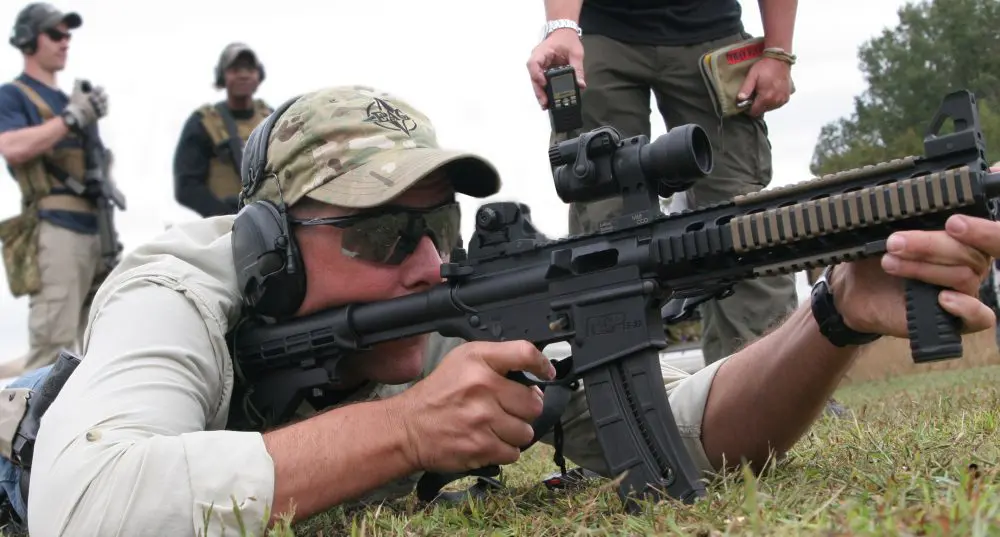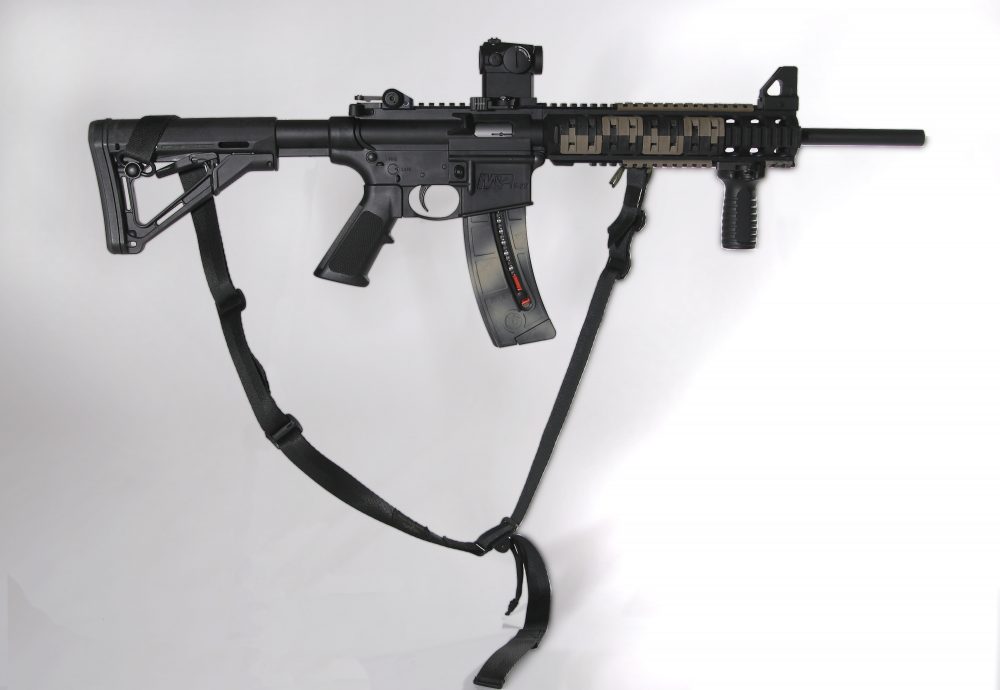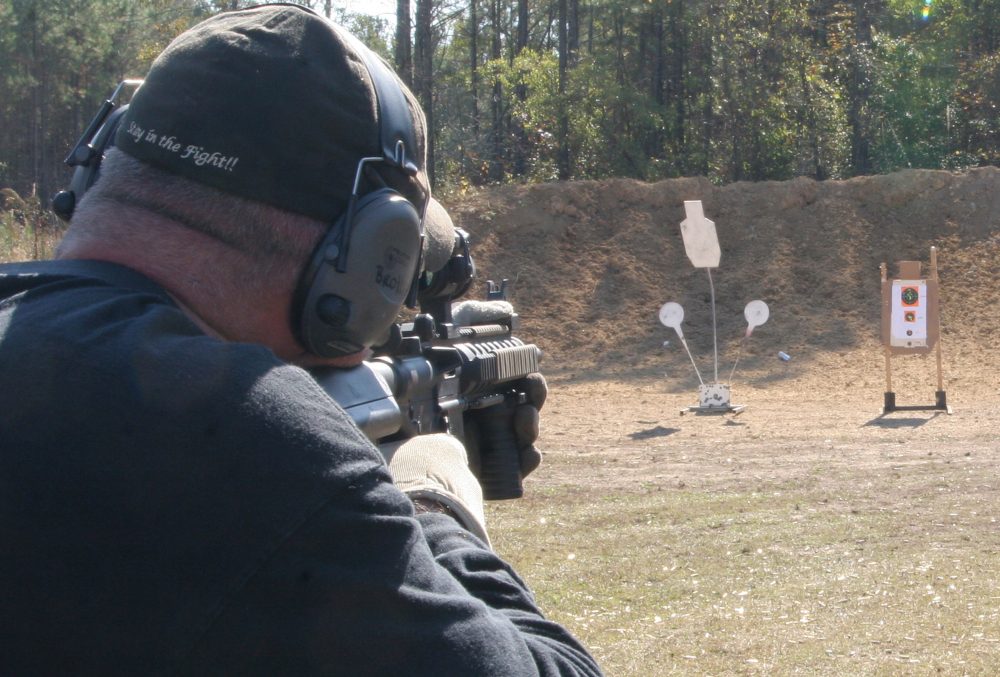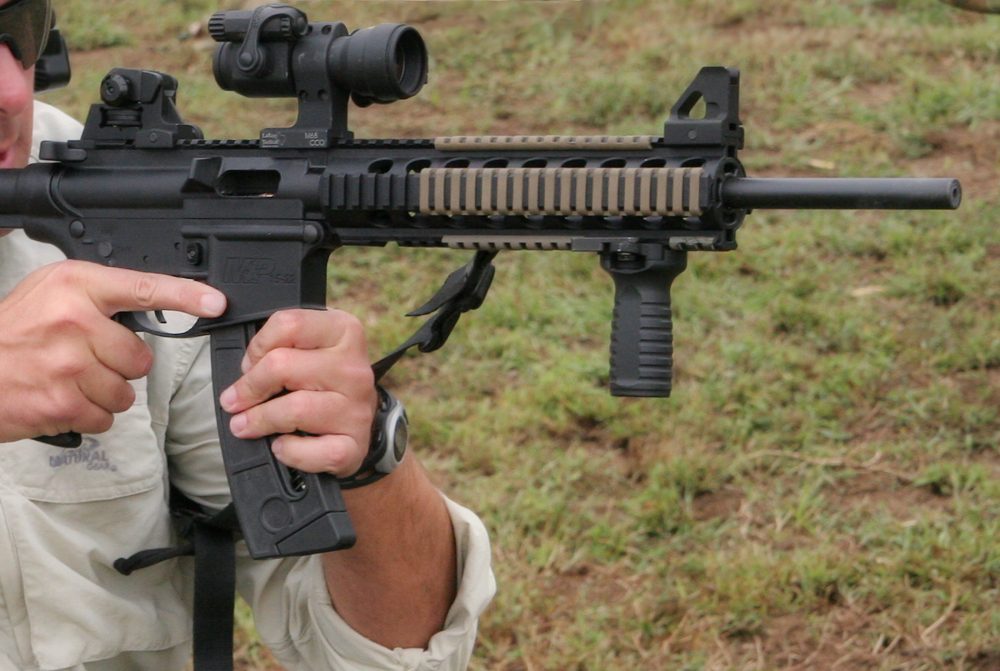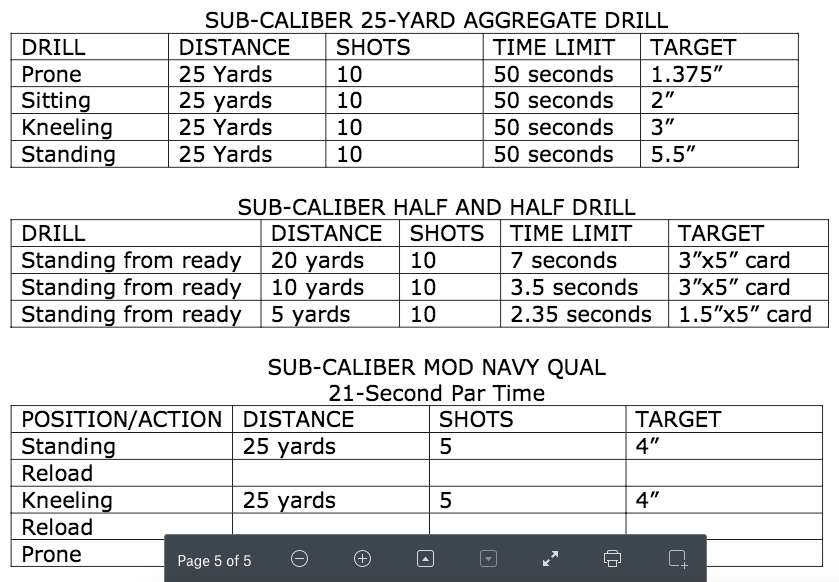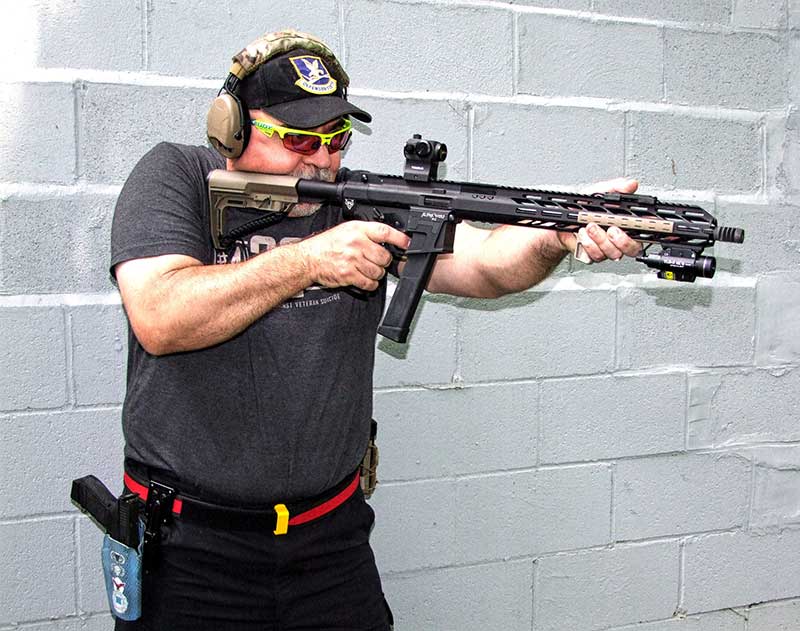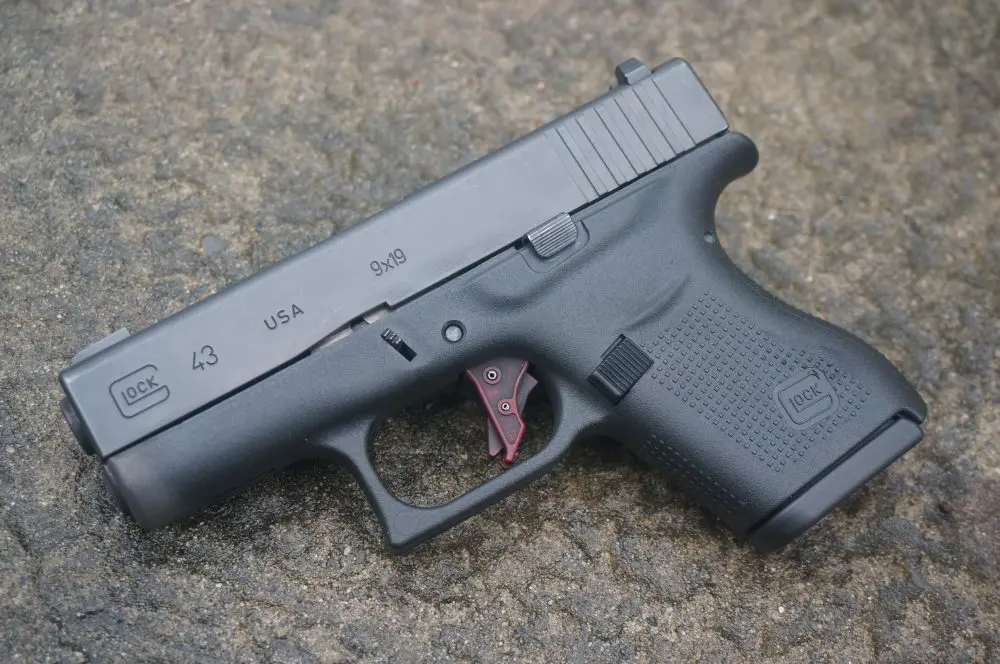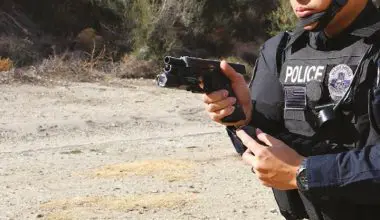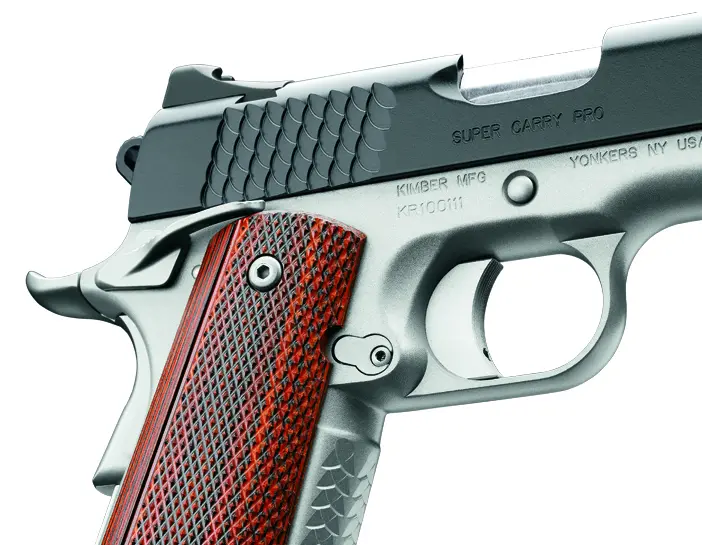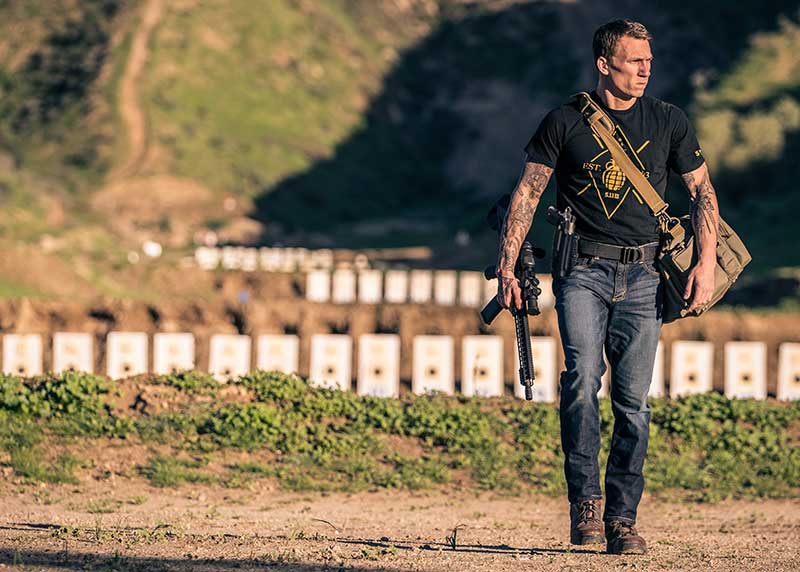High-quality rimfire surrogates, such as S&W M&P15-22, allow serious training that was previously out of reach to those without a rich uncle and ready bunker of unit ammo.
The explosion of interest in the AR platform and the rising cost/scarcity of 5.56mm ammunition have generated unprecedented interest in sub-caliber training solutions for serious training and skills development.
The market has a wide (and growing) number of .22 LR conversion solutions. These include AR-style stock adapters for rimfires such as the Ruger 10/22, as well as complete .22 rifles that mimic AR form, feel and function, such as the Smith & Wesson M&P 15-22. I have worked extensively with a Ruger 10/22 with an AR stock, and the Smith & Wesson M&P 15-22, and can directly attribute measurable increases in my shooting performance to the affordable, low noise/recoil repetitions that the rifles allowed.
The sub-cal trainer is really coming into its own of late. My initial attempts to incorporate some old GI conversions into organizational training were frustrating at best, and past shooters have struggled to get the most out of dissimilar but readily available rimfire rifles. The new solutions in stocks, conversions, upper receivers and complete rifles can be made to really stretch training dollars and range time.
I recently used a complete M&P 15-22 rifle to shoot an EAG Tactical Carbine Course, testing how closely to its full-power counterpart the rimfire carbine would perform in the variety of scenarios that Pat Rogers’ excellent class encompasses.
The S&W and similar rifles allow nearly identical manipulations across the range of common tasks.
M&P shoots Mod Navy Qual as primary carbine at EAG Tactical carbine course.
There were approximately eight stoppages in nearly 1,000 rounds of training, but each reduced using the same immediate and remedial actions that would return an M4 to the fight. Most of these stoppages looked to be related to ammunition quality control, and no drama. This particular trainer even locks the bolt back after ejecting the last round, and drops the bolt with the familiar controls. It was an unqualified success as a training surrogate, and only required a few (as in under three) rounds of real-deal 5.56mm to get back onto the increased noise and bounce when switching back and forth.
Score differences between the trainer and an exemplar M4 style in the MEU(SOC) qual were insignificant. Being able to train so seriously with a rimfire would have been unthinkable even a few short years ago and opens new territory to sub-caliber training.
Here I will look at some specially tailored drills that will help shooters get the most out of their sub-caliber gear. All are modified versions of drills used by nationally known trainers in their carbine courses. The drills have been modified to accommodate 25-yard ranges, understanding that most commercial indoor ranges are 25 yards. Many suburbanites and city folk may only have regular access to such ranges and can use these drills with the rimfire carbine to get onto a “pistol” range in between infrequent centerfire carbine training or classes.
Even on outdoor ranges, 25 yards allows great visual feedback without having to take the time to walk downrange. These drills have also been tweaked to ensure that the reduced recoil is accounted for, forcing the shooter to control the negligible recoil with an aggressive stance and build good combat marksmanship habits. If a shooter can ace these drills in the modified times and target sizes, he will be ready for the real drill with the service rifle (qual monkey excepted).
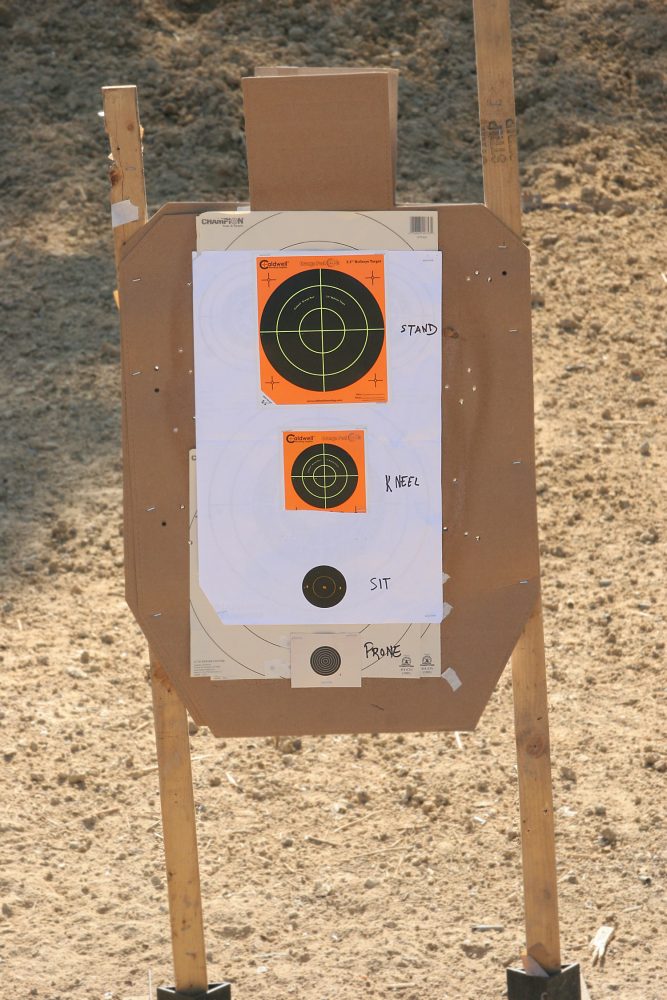
Table of Contents
POSITIONAL ACCURACY
The Viking Tactics 100-Yard Aggregate Drill is a tremendous drill to emphasize practical accuracy from various body positions while maintaining an emphasis on shot-to-shot recovery. The standard drill has the shooter engaging a 5.5-inch bull (B-8 repair center) from 100 yards (prone), 75 yards (sitting), 50 yards (any kneeling position), and 25 yards (standing), each with ten shots in a time limit of 60 seconds.
Each distance/position is optimized to force the shooter to maintain natural point of aim and apply sound fundamentals while taking the first, best sight picture in order to make the time hack.
To make the 100-Yard Aggregate Drill a reduced range/rimfire drill, the shooter must use some different bull sizes and maintain the 25-yard line. A word on zeros is in order here. With the exception of the EAG class, where I used the same 50-yard zero I run on my carbines, I tend to use a 25-yard zero on the trainers. Trying to estimate 25-yard holdover from a 50- (or 100-) yard zero and apply that against extremely small, simulated 100-yard shots is counterproductive to me. Your results or training priorities may differ.
The prone segment is shot against a 1.375-inch target. The traditional smallbore A-36 competition bull works perfectly and is available from any well-stocked target supplier.
The sitting at 25 yards technically requires a 1.83-inch bull, but it is far more practical to simply use a two-inch target spot and only count hits that are fully within the bull and do not break the outer edge, giving you the same practical result.
The kneeling segment uses a three-inch target and the same principle to approximate the required 2.75 inches.
Standing uses the actual 5.5-inch bull at the same 25 yards.
Each of these should be run with the designated ten required shots, but the time limit is reduced to 50 seconds to account for the decrease in recoil. An accomplished shooter can run this drill within the time limits and get 35 or better of the 40 hits. This is a great drill to increase a shooter’s accuracy, and the diminished recoil and blast allow the shooter to really focus on a clean press of the trigger and solid follow-through while getting the most support out of each position.
Since it can easily be set up on a single target backer and seen/scored from the firing line, it is very easy to shoot this drill repeatedly, where the pure version can be a little difficult to set up on a public range.
This is a drill I like to use to build support-side accuracy and to work through any awkwardness from the support side without breaking the bank with ammo cost. When using the reduced 100-Yard Aggregate Drill for the support side, I increase the time limit for each position back to the original 60 seconds.
Viking Tactics instructor Dan B. shoots reduced-scale 25-yard aggregate version of 100-Yard Aggregate with 15-22.
SPEED!
My current favorite drill to work on raw speed in shot-to-shot recovery against a practical target is the Half and Half drill as used by Viking Tactics.
The Half and Half requires a shooter to fire ten shots into the same 5.5-inch target as used above, but this time from 20 yards in ten seconds, from ten yards in five seconds, and then finally, from five yards in a mere 2.5 seconds! This drill is tough and can humble some serious shooters. Controlling the recoil to break the shot as fast as is required while maintaining the smallish bull is a challenge. In addition, the high number of shots makes the shooter firm up the position as aggressively as possible.
To prevent this aspect becoming lost with the .22, the targetry is reduced significantly to get a similar effect within the smaller bounce in the RDS/irons. For the 20- and ten-yard lines, a vertically placed 3”x5” index card is used, while the card is folded in half to become a vertical 1.5-inch strip at five yards. This narrow strip forces the shooter to really control the weapon, even with the reduced recoil of the .22. The narrow vertical target also demands a clean rearward press rather than allowing the shooter to crunch through applying pressure to the side of the trigger.
The times are reduced correspondingly, to force the shooter to manipulate the trigger as rapidly as possible. The 20-yard 3”x5” card is run in seven seconds, while the ten-yard card gets ten shots in 3.5 seconds. The five-yard strip is simply too small to run in the corresponding 70% of the original, so 2.35 seconds is a good marker. At these times, the shooter is doing all he or she can to break and release the trigger until reset.
Once the finger gets used to moving this fast, the skill transfers over pretty well to the “large” 5.5-inch target and increased recoil with the 5.56mm. Many shooters struggle so much with controlling recoil that their finger never truly learns to move through the trigger arc and reset as rapidly as possible. The rimfire provides a great opportunity to boost that speed.
Again, running this drill from the support side, the reduced targets can be used against the original par times of 10, 5, and 2.5 seconds.
Depending on trainer being used, reloads may or may not be practical to train in sub-caliber drills. S&W rimfire locks bolt back on empty mags and reloads with same controls as service carbine.
PUTTING IT TOGETHER
The Mod Navy Qual as used by Trident Concepts and EAG Tactical is a tremendous drill to balance speed and practical accuracy within multiple positions while including reloads. The drill is shot to an eight-inch circle within a silhouette from 50 yards. Par time is 25 seconds to fire five shots each from standing, kneeling, and prone positions, reloading between each position and dropping the bolt to chamber a round.
The scoring system is a little odd, with the shooter gaining two negative points for each second under the 25-second par and being penalized one positive point for every second over the limit. Points within the vitals are zero, while outside hits cost one positive point each. The object is to print a negative score, ideally from posting a clean run in under 25 seconds. This is easier said than done, but in any good carbine class there are a few shooters who will end up between negative three and ten.
The sub-caliber Mod Navy Qual can be run two ways: one for rifles like the M&P 15-22 that allow full parallel manipulations to the 5.56mm carbines, and another for trainers like the Rugers. Since the adapter-stocked rifles have such different manipulations, reloads are best not emphasized, and the drill is shot straight through.
With the AR-type guns, the drill is shot to three consecutive four-inch targets at 25 yards, five shots to one target, each target from standing, kneeling and prone. Reloads are conducted in the transitions as with the full power drill, and the par time is reduced to 21 seconds to compensate for the decreased bounce. The separate targets are used to isolate the accuracy results from each position and identify any weak points.
If using an adapter-stocked rifle, the drill is run similarly without the reloads in a time limit of 15 seconds.
This is a deceptively simple drill that requires the shooter to take the first, best shot, rapidly recover to follow ups with equal precision, then fluidly move and combine actions in order to be set up ready to control the next five shots without wasted motion.
There are drills that a shooter can practice until his performance on the specific drill exaggerates his overall skill level—this is not one of them. A shooter who can consistently print negatives on the Mod Navy has his act together.
SUMMARY
These three drills represent a good balance of basic carbine skills and make a solid range session that can be set up easily and accomplished in minimal time. They also allow a shooter to track progress over time and push for better measurable performance. Be forewarned that none of these will inflate the ego, as the standards are set to accommodate serious mission-type users.
The sub-caliber trainer is a tremendous tool that is more accessible and makes greater sense than ever before. Shake out the kinks with these drills and establish sound fundamentals on the cheap before moving on to the next round of drills with larger calibers.
